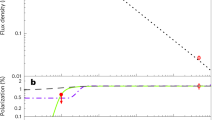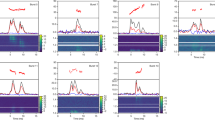Abstract
Gamma-ray bursts (GRBs) are the strongest explosions in the Universe since the Big Bang. They are believed to be produced either in the formation of black holes at the end of massive star evolution1,2,3 or the merging of compact objects4. Spectral and timing properties of GRBs suggest that the observed bright gamma-rays are produced in the most relativistic jets in the Universe4; however, the physical properties (especially the structure and magnetic topologies) of the jets are still not well known, despite several decades of studies. It is widely believed that precise measurements of the polarization properties of GRBs should provide crucial information on the highly relativistic jets5. As a result, there have been many reports of GRB polarization measurements with diverse results (see ref. 6); however, many such measurements suffer from substantial uncertainties, most of which are systematic (ref. 7 and the references therein). After the first successful measurements by the Gamma-Ray Burst Polarimeter (GAP) and Compton Spectrometer and Imager (COSI) instruments8,9,10, here we report a statistically meaningful sample of precise polarization measurements, obtained with the dedicated GRB polarimeter POLAR onboard China’s Tiangong-2 space laboratory. Our results suggest that the gamma-ray emission is at most polarized at a level lower than some popular models have predicted, although our results also show intrapulse evolution of the polarization angle. This indicates that the low polarization degrees could be due to an evolving polarization angle during a GRB.
This is a preview of subscription content, access via your institution
Access options
Access Nature and 54 other Nature Portfolio journals
Get Nature+, our best-value online-access subscription
$29.99 / 30 days
cancel any time
Subscribe to this journal
Receive 12 digital issues and online access to articles
$119.00 per year
only $9.92 per issue
Buy this article
- Purchase on Springer Link
- Instant access to full article PDF
Prices may be subject to local taxes which are calculated during checkout



Similar content being viewed by others
Data availability
All data that support the plots within this paper and other findings of this study are available from the POLAR Collaboration (merlin.kole@unige.ch) upon reasonable request.
References
Woosley, S. E. Gamma-ray bursts from stellar mass accretion disks around black holes. Astrophys. J. 405, 273–277 (1993).
Iwamoto, K. et al. A hypernova model for the supernova associated with the γ-ray burst of 25 April 1998. Nature 395, 672–674 (1998).
MacFadyen, A. I. & Woosley, S. E. Collapsars: gamma-ray bursts and explosions in ‘failed supernovae’. Astrophys. J. 524, 262–289 (1999).
Gehrels, N. & Razzaque, S. Gamma-ray bursts in the Swift–Fermi era. Front. Phys. 8, 661–678 (2013).
Toma, K. et al. Statistical properties of gamma-ray burst polarization. Astrophys. J. 698, 1042–1054 (2009).
Covino, S. & Götz, D. Polarization of prompt and afterglow emission of gamma-ray bursts. Astron. Astrophys. Trans. 29, 205–239 (2016).
McConnel, M. High energy polarimetry of prompt GRB emission. New Astr. Rev. 76, 1–21 (2017).
Lowell, A. W. et al. Polarimetric analysis of the long duration gamma-ray burst GRB 160530A with the balloon borne Compton Spectrometer and Imager. Astrophys. J. Lett. 848, 119–129 (2017).
Yonetoku, D. et al. Magnetic structures in gamma-ray burst jets probed by gamma-ray polarization. Astrophys. J. Lett. 758, L1 (2012).
Yonetoku, D. et al. Detection of gamma-ray polarization in prompt emission of GRB 100826A. Astrophys. J. Lett. 743, L30 (2011).
Produit, N. et al. Design and construction of the POLAR detector. Nucl. Instrum. Methods Phys. Res. A 877, 259–268 (2018).
Li, Z. H. et al. In-orbit instrument performance study and calibration for POLAR polarization measurements. Nucl. Instrum. Methods Phys. Res. A 900, 8–24 (2018).
Kole, M. et al. Instrument performance and simulation verification of the POLAR detector. Nucl. Instrum. Methods Phys. Res. A 872, 28–40 (2017).
Koshut, T. M. et al. T 90 as a measurement of the duration of GRBs. 186th AAS Meeting of the Bulletin of the American Astronomical Society 886 (Conference Series Volume 27, American Astronomical Society, 1995).
Maier, D., Tenzer, C. & Santangelo, A. Point and interval estimation on the degree and the angle of polarization: a Bayesian approach. Publ. Astron. Soc. Pac. 126, 459–468 (2014).
Westfold, K. C. The polarization of synchrotron radiation. Astrophys. J. 130, 241–258 (1959).
McMaster, W. H. Matrix representation of polarization. Rev. Mod. Phys. 33, 8–28 (1961).
Lazzati, D., Rossi, E., Ghisellini, G. & Rees, M. J. Compton drag as a mechanism for very high linear polarization in gamma-ray bursts. Mon. Not. R. Astron. Soc. 347, L1–L5 (2004).
Granot, J. The most probable cause for the high gamma-ray polarization in GRB 021206. Astrophys. J. Lett. 596, L17–L21 (2003).
Lan, M. X., Wu, X. F. & Dai, Z. G. Gamma-ray burst optical afterglows with two-component jets: polarization evolution revisited. Astrophys. J. 860, 44–51 (2018).
Rossi, E. M., Lazzati, D., Salmonson, J. D. & Ghisellini, G. The polarization of afterglow emission reveals gamma-ray bursts jet structure. Mon. Not. R. Astron. Soc. 354, 86–100 (2004).
Gill, R. & Granot, J. Afterglow imaging and polarization of misaligned structured GRB jets and cocoons: breaking the degeneracy in GRB 170817A. Mon. Not. R. Astron. Soc. 478, 4128–4141 (2018).
Rees, M. J. & Meszaros, P. Unsteady outflow models for cosmological gamma-ray bursts. Astrophys. J. Lett. 430, L93–L96 (1994).
Paczynski, B. & Xu, G. Neutrino bursts from gamma-ray bursts. Astrophys. J. 427, 708–713 (1994).
Mészáros, P. & Rees, M. J. Steep slopes and preferred breaks in gamma-ray burst spectra: the role of photospheres and comptonization. Astrophys. J. 530, 292–298 (2000).
Rees, M. J. & Mészáros, P. Dissipative photosphere models of gamma-ray bursts and X-ray flashes. Astrophys. J. 628, 847–852 (2005).
Zhang, B. & Yan, H. The internal-collision-induced magnetic reconnection and turbulence (ICMART) model of gamma-ray bursts. Astrophys. J. 726, 90–113 (2011).
Lundman, C., Vurm, I. & Beloborodov, A. M. Polarization of gamma-ray bursts in the dissipative photosphere model. Astrophys. J. 856, 145 (2018).
Deng, W., Zhang, H., Zhang, B. & Li, H. Collision-induced magnetic reconnection and a unified interpretation of polarization properties of GRBs and blazars. Astrophys. J. Lett. 821, L12–L19 (2016).
Xiong, S. L. et al. Overview of the GRB observation by POLAR. In 35th International Cosmic Ray Conference 640 (Proceedings of Science, 2017).
Band, D. et al. BATSE observations of gamma-ray burst spectra. I—spectral diversity. Astrophys. J. 413, 281–292 (1993).
Avni, Y. Energy spectra of X-ray clusters of galaxies. Astrophys. J. 210, 642–646 (1976).
GCN Circular: GRB 170114A: Fermi GBM Detection (2015); https://gcn.gsfc.nasa.gov/other/170114A.gcn3
Acknowledgements
We gratefully acknowledge financial support from the National Basic Research Program (973 Program) of China (grant number 2014CB845800); Joint Research Fund in Astronomy, under cooperative agreement between the National Natural Science Foundation of China and Chinese Academy of Sciences (grant number U1631242); National Natural Science Foundation of China (grant numbers 11503028 and 11403028); Strategic Priority Research Program of the Chinese Academy of Sciences (grant number XDB23040400); Swiss Space Office of the State Secretariat for Education, Research and Innovation (ESA PRODEX Programme); National Science Center of Poland (grant number 2015/17/N/ST9/03556); and Youth Innovation Promotion Association of the Chinese Academy of Sciences (grant number 2014009). We also thank J. M. Burgess of MPE, Garching, Germany, for providing the energy spectra for GRB 170114A.
Author information
Authors and Affiliations
Contributions
T.-W.B., T.Batsch, T.Bernasconi, F.C., J.-Y.C., Y.-W.D., N.G., W.H., M.K., H.-C.L., L.L., Z.-H.L., J.-T.L., X.L., R.M., S.O., M.P., N.P., D.R., H.-L.S., L.-M.S., J.-C.S., J.S., T.T., R.-J.W., X.Wen, B.-B.W., X.Wu, H.-L.X., S.-L.X., L.-Y.Z., L.Z., S.-N.Z., X.-F.Z., Y.-J.Z. and A.Z. contributed to the development of the mission concept and/or construction and testing of POLAR. M.K., Z.-H.L., N.P., J.-C.S., Y.-H.W., S.-L.X. and S.-N.Z. were involved in the presented analysis. Z.-G.D., M.-X.L. and X.-F.W. contributed to the theoretical discussions. The manuscript was produced by M.K., Z.-H.L., J.-C.S., Y.-H.W. and S.-N.Z. The principal investigators of the POLAR collaboration are S.-N.Z., M.P. and X.Wu.
Corresponding authors
Ethics declarations
Competing interests
The authors declare no competing interests.
Additional information
Publisher’s note: Springer Nature remains neutral with regard to jurisdictional claims in published maps and institutional affiliations.
Supplementary information
Supplementary Information
Supplementary Figures 1–12, Supplementary Tables 1–7, Supplementary References 1–20
Rights and permissions
About this article
Cite this article
Zhang, SN., Kole, M., Bao, TW. et al. Detailed polarization measurements of the prompt emission of five gamma-ray bursts. Nat Astron 3, 258–264 (2019). https://doi.org/10.1038/s41550-018-0664-0
Received:
Accepted:
Published:
Issue Date:
DOI: https://doi.org/10.1038/s41550-018-0664-0
This article is cited by
-
Gas microchannel plate-pixel detector for X-ray polarimetry
Nuclear Science and Techniques (2024)
-
Proton irradiation of SiPM arrays for POLAR-2
Experimental Astronomy (2023)
-
Variably polarized X-ray sources for LPD calibration
Experimental Astronomy (2023)
-
Recent advances in the study of the prompt emission of gamma-ray bursts
Journal of Astrophysics and Astronomy (2022)



